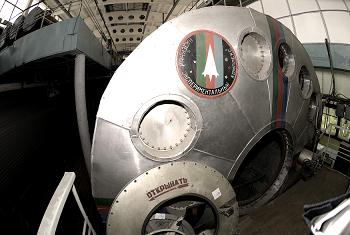The Mars500 experiment is a cooperative project between the European Space Agencyâs Directorate of Human Spaceflight and the Russian Institute for Biomedical Problems (IBMP).
The experiment will be conducted inside a special facility at the IBMP in Moscow.
Mars500 is essential for the preparation of human missions to Mars, as the data, knowledge, and experience accumulated during the experiment will help scientists investigate the human factors of this type of mission.
Many aspects of long duration spaceflights are targeted by this study: crew composition, the influence of isolation on sleep, mood, and mental health, the impact of different personalities, cultural background, and motivation of the crew members, and the effects of stress on health and the immune system.
There is one 150-day simulation to be conducted (that can be followed by an additional 150-day study) before the full 520-day simulation. The full simulation follows the profile of a real mission to Mars, which contains an exploration phase that has to be performed by the crew of six selected for the experiment.
During the experiments, the crews will have a diet identical to the one that the ISS crews have and communication with the outside world will involve a delay (as in the real conditions of a space mission, when the spacecraft and the mission control are millions of kilometers away from each other).
The crew will be completely isolated, and they will have to handle all of the critical situations for the duration of the experiment. The crew will speak English and Russian, and have experience in medicine, biology, and engineering.
The facility at IBMP is known as the Ground-based Experimental Complex (GEC or NEK in Russian). Besides the isolation facility (or the mockup of the habitable modules of a spacecraft), the facility also contains technical facilities, offices, and an operations room.
The isolation facility contains four interconnected modules, which are used by the crew for daily activities.
It also contains a module that will simulate the Martian landscape and it will be used for activities on the surface of Mars during the simulated landing.
The four modules are designated as the medical module, the living quarters, the Mars landing module, and the storage module. The medical module will be used for routine medical examinations, and eventually for complex medical investigations in the case of any crew member becoming ill. The living quarters module contains individual compartments for the crew members, and also a living room, and a kitchen. The control room will also be part of this module.
The Mars landing module will accommodate the landing crew during the orbiting of Mars phase of the mission. Three of the crew members will have to live and work inside this module for up to 3 months. The storage module contains a refrigerator for food storage, a storage compartment for non-perishable food, a greenhouse, a gym, a bathroom, and even a sauna.
The start of the full 520-day study is planned for late 2009, when a six-member crew will be sealed behind the entry hatch in order to live and work in the conditions of a complete Mars mission.
For more information about the Mars500 project, check out the dedicated page on the IBMP web site.











 Subscribe to our RSS feed
Subscribe to our RSS feed











[…] on a découvert la mission Mars 500 (Lisez “La course vers Mars est lancée” ou “Mars 500″ (en Anglais) pour en savoir […]
[…] friends. Short of an illness, no tribal vote or eviction would have given them a ticket out. It was all in the name of science – to see if astronauts could psychologically and physically handle the long trip to Mars in such […]
Add A Comment